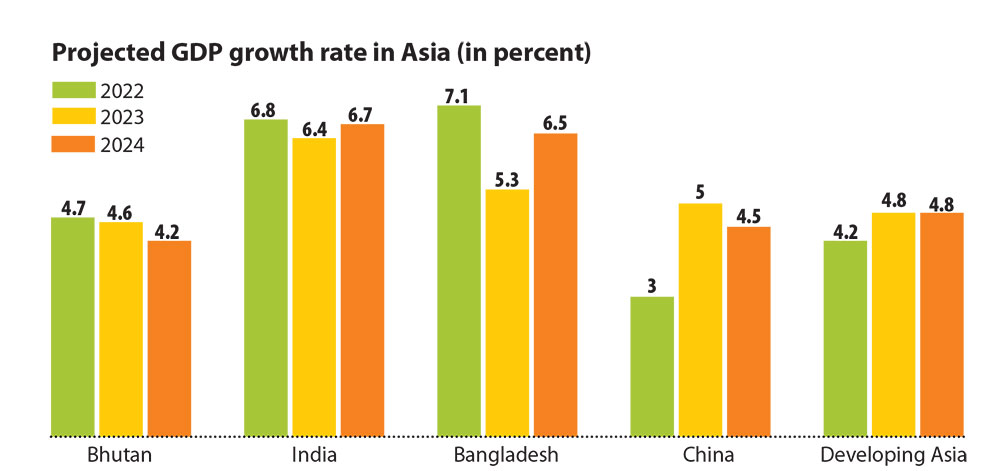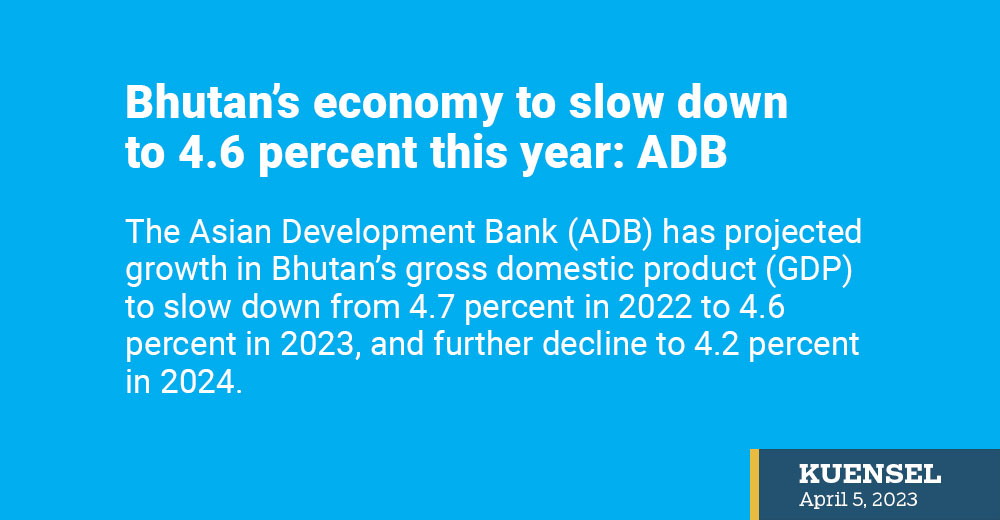Thukten Zangpo
The Asian Development Bank (ADB) has projected growth in Bhutan’s gross domestic product (GDP) to slow down from 4.7 percent in 2022 to 4.6 percent in 2023, and further decline to 4.2 percent in 2024.
These projections are based on the Bank’s Asian Development Outlook April 2023 released yesterday.
However, the economic growth saw a 0.6 percentage points revision up from the Bank’s earlier projection of September last year at 4 percent in 2023.
The ADB’s Bhutan Resident Mission Economics Officer, Sonam Lhendup, said that the decline in investment caused by emerging domestic macroeconomic issues, national elections in December this year, and the transition to a new government five-year plan would slow the growth this year and the next year.
While the country’s hydropower production returning to normal after two years of decline would add growth this year, he said, the two newly-commissioned hydropower plants—Punatshangchhu-II and Nikachhu would help sustain growth by 2024.
“The plants are expected to raise the country’s GDP by 3 percentage points,” Sonam Lhendup said.
At the same time, India’s expected robust economic growth prospects in 2023 and 2024 would boost Bhutan’s export and growth, according to the ADB. India is a major trade partner for Bhutan.
With Bhutan opening its economy to tourism from September last year, the recovery in tourist arrivals has been slow due to the increase in the sustainable development fee, the Bank said. However, the tourist arrivals this year would be higher than in 2022 and boost foreign reserves and services but remain below the 2019 level.

Similarly, wholesale and retail trade is expected to contract as import restrictions are sustained to reduce pressure on foreign exchange reserves.
According to the Bank, the gross international reserves declined by 20 percent to USD 755 million to cover 4.7 months of merchandise and service imports in 2022.
The agriculture sector growth is forecast at 3.2 percent in 2023 and 2.6 percent in 2024, as the government continues to invest in agricultural infrastructure, value chain creation, and contingency measures to address the rising issue of human-wildlife conflict.
For the industry sector, the growth is forecast at 5 percent in 2023 with increased electricity output, reaching the 2020 level on expected better hydrological flow and less maintenance downtime—two factors that held back generation in 2021 and 2022.
However, mining and quarrying will be hampered by changes in export policy.
The construction sector is expected to slow with 1,020 megawatt Punatshangchhu-II and Nikachhu nearing completion. The commissioning of these two plants will see a 5.4 percent growth in industry growth by 2024.
Inflation will likely moderate to 5.5 percent in 2023, given the government’s food security drive, domestic food prices are expected to remain low, offsetting some imported inflation.
The Bank said that the moderation of inflation in India to 5 percent in 2023 and slowing further to 4.5 percent in 2024 will help contain inflation in Bhutan. Bhutan’s imports from India constitute about half of the country’s consumer price index.
With improvements to the global supply chain and the geopolitical situation, and with the moderation of inflation in India, average inflation in Bhutan is forecast at 5.1 percent in 2024.
However, the Bank said that the country’s widening fiscal deficit and declining foreign exchange reserves will remain key concerns for Bhutan.


